Upon trying this dish at an Osaka eatery, I was intrigued to recreate it at home. A key note - Shiso leaves do elevate the flavor significantly.

There's a whisper of a memory that tickles your senses each time you dive into a recipe like this. It's the familiar, comforting feeling of home. Of something steeped in tradition and passed down through generations, of history carefully folded into every bite. And that's what this Miso Glazed Eggplant Recipe, or as we fondly call it in Japan, 茄子の味噌焼き, brings to the table.
This dish carries the ancient charm of Japan in its heart. Picture the old times: a grandmother lovingly preparing dinner in a traditional Japanese kitchen. The rustic miso, earthy eggplant, the tangy mirin, the rich sake, they're all staples, reflecting a lifestyle that believes in embracing the gifts of nature. She takes her time preparing each ingredient, and the air fills with a mix of the intriguing aroma of miso and the gentle sweetness of mirin, the scent dancing around the home, inviting everyone to the dinner table.
Now fast forward to the present, where you are about to embark on this time-honored culinary journey. As you handle the eggplant, you're not just working on a vegetable, but a piece of Japanese tradition, a cultural gem that has stood the test of time.
So, you're not just about to cook. You're about to bring alive a slice of Japanese tradition in your kitchen. You're about to build bridges with flavors, reaching out from your kitchen to the heart of Japan. And trust me, each bite of this savory-sweet glazed eggplant will be an experience, a delightful trip down the memory lane of Japanese culinary history.
JUMP TO:
INGREDIENTS:
Japanese Eggplants: Japanese eggplants, with their slender shape, tender skin, and minimal seeds, are the star of this recipe. When selecting, look for ones with a bright, shiny, smooth skin that's a deep purple color. They should be firm to touch but not rock-hard. Avoid any with wrinkled skin, soft spots, or blemishes as these are signs of age or damage. If Japanese eggplants are unavailable, you can substitute other small, thin eggplants varieties, such as Chinese or Italian eggplants.
Roasted Sesame Oil: This ingredient lends a rich, nutty flavor to the dish that's truly distinctive. Always opt for a high-quality, pure sesame oil that doesn't include any other oil types in the ingredients list. The color should be a deep brown, and the smell should be strong and aromatic. Store it in a cool, dark place to preserve its flavor.
White Miso: This traditional Japanese ingredient brings a deep umami flavor to the dish. Choose white (shiro) miso that's lighter in flavor than red or mixed miso. It should have a smooth texture. Good-quality miso can be found in the refrigerated section of an Asian supermarket or health food store. An alternative could be a mild soybean paste if you can't find miso, but keep in mind that the flavor profile will be slightly different.
Mirin: Mirin is a sweet rice wine vital to Japanese cooking. It adds sweetness and helps to balance the savory miso and sesame oil. Authentic mirin has a light golden color and should not be confused with mirin-like condiments or aji-mirin, which contain less alcohol and more additives. If you can't find mirin, a mix of sweet white wine and a bit of sugar can serve as a makeshift substitute.
Sake: A staple in Japanese cuisine, sake contributes to the complexity of the dish's flavors. Opt for a cooking sake, also known as ryorishi, which can be found in Asian grocery stores. In its absence, a dry sherry or Chinese rice wine can also work.
Shiso Leaves: Shiso leaves, also known as perilla, are a type of herb with a unique flavor that's somewhere between mint, basil, and anise. For the freshest shiso, the leaves should be vibrant and perky without any signs of wilting or browning. If shiso is hard to find, a mixture of basil and mint leaves can mimic its flavor profile.
Toasted White Sesame Seeds: Toasted sesame seeds add a delightful crunch and extra nuttiness to the dish. You can buy them pre-toasted, or toast raw sesame seeds yourself in a dry pan over medium heat until they're golden brown. Watch them closely as they can burn quickly!
MAIN STEPS:
Preparation: The first step to any successful recipe is thorough preparation. Be sure to gather all your ingredients before you start (Step 1), as this will allow for a seamless cooking experience. The last thing you want is to be searching for something while your dish is halfway through cooking!
Oven rack position: The position of the oven rack (Step 2) plays a crucial role in the even cooking of the eggplants. Ensure it's in the middle to avoid any part of the eggplant getting too close to the heating element and burning.
Dissolving sugar in miso: In Step 4, it's important to stir until the sugar fully dissolves into the miso. This helps create a smooth glaze and ensures that the sweetness is evenly distributed.
Slicing the eggplants: As you slice the eggplants (Step 8), be mindful not to cut too deep into the flesh. Your cuts should be shallow, as this ensures the eggplant cooks evenly without falling apart. These cuts also increase the surface area, allowing the glaze to seep in and flavor the eggplant more effectively.
Soaking the eggplants: Don't skip Step 9! Soaking the eggplants helps to remove any bitterness, resulting in a sweeter, more flavorful end result.
Basting the eggplants with oil: When brushing the eggplants with sesame oil (Step 11), make sure to cover the entire cut surface. The oil not only adds flavor but also helps the eggplants cook evenly and prevents them from drying out in the oven.
Broiling the eggplants: When it's time to broil the eggplants (Step 18), keep a close eye on them. Broiling can quickly go from done to burnt because of the intense heat. Look for bubbling in the glaze and a slightly caramelized top.
Garnishing: Finally, don't rush the garnishing process (Step 20). Sprinkle the sesame seeds, green onions, and shiso leaves evenly over the eggplants. This not only adds to the aesthetic appeal of the dish but also gives each bite a balanced taste.
SERVED WITH:
Starter: Kakitamajiru (Japan): This is a Japanese-style egg drop soup, made with a simple soy-based broth, silky strands of beaten egg, and often garnished with finely sliced scallions or other green herbs. It's a light, comforting start that paves the way for the robust flavors of Miso Glazed Eggplant.
Main Course: Teriyaki Salmon (Japan): This dish involves grilling or pan-frying a salmon fillet and glazing it with teriyaki sauce, which is a sweet and tangy sauce made from soy sauce, mirin, and sugar. The flavorful salmon pairs beautifully with the umami-rich Miso Glazed Eggplant.
Second Main: Tonkatsu (Japan): Tonkatsu is a breaded, deep-fried pork cutlet, usually served with shredded cabbage and a thick, sweet tonkatsu sauce. The crunchy texture and hearty flavors of the tonkatsu make it a satisfying follow-up to the Miso Glazed Eggplant.
Side Dish: Yakitori-Style Grilled Vegetables (Japan): Yakitori usually refers to skewered, grilled chicken, but can also include vegetables. Grilled veggies, lightly seasoned and charred, add a smoky flavor that complements the Miso Glazed Eggplant.
Second Side Dish: Nikujaga (Japan): Nikujaga is a comforting stew of meat (usually thinly sliced beef) and potatoes, cooked in a sweet and salty soy-based sauce. The hearty and warm flavors of the nikujaga provide a delicious contrast to the Miso Glazed Eggplant.
Dessert: Yuzu Sorbet (Japan): Yuzu is a citrus fruit native to East Asia that has a flavor profile somewhere between a lemon, mandarin orange, and grapefruit. Yuzu sorbet is a refreshing palate cleanser that's light and tangy, providing a refreshing end to a meal.
ALTERNATIVES:
Appetizer: Baba Ganoush (Middle East): This is a Levantine dish made primarily from roasted eggplants, tahini (which is similar to sesame paste), garlic, and lemon juice. Like the Miso Glazed Eggplant, Baba Ganoush also showcases the creaminess of eggplants, but with a different flavor profile.
Main Course: Miso Soup with Tofu and Vegetables (Japan): This is a classic Japanese dish that incorporates the umami flavors of miso. This versatile soup can also include a variety of ingredients such as tofu, green onions, and mushrooms. It offers a lighter alternative to the Miso Glazed Eggplant.
Side Dish: Mirin Glazed Carrots (Japan): This Japanese side dish features carrots glazed with mirin, a sweet Japanese rice wine, similar to the mirin used in Miso Glazed Eggplant. The sweetness of the mirin and the natural sweetness of the carrots create a harmonious flavor.
Main Course: Eggplant Parmigiana (Italy): A classic Italian dish where eggplant slices are breaded, fried, and layered with tomato sauce, mozzarella, and Parmesan cheese, then baked. It showcases the eggplant in a completely different style, more robust and hearty.
Side Dish: Gomaae (Japan): This is a Japanese dish consisting of boiled spinach dressed with a sesame sauce. The sesame seeds in the dressing mirror the sesame oil used in the Miso Glazed Eggplant, and both dishes have a nutty undertone.
Dessert: Sesame Seed Brittle (Global): This is a simple, widely enjoyed dessert made by caramelizing sugar and mixing in toasted sesame seeds, then allowing the mixture to harden into a brittle. It offers a sweet finish that still echoes the sesame flavor found in the Miso Glazed Eggplant.
HISTORY:
Embracing the silky texture and rich, almost meaty flavor of the eggplant, the Miso Glazed Eggplant Recipe (Nasu no Miso Dengaku or 茄子の味噌焼き) stands as a testament to the creative and ingenious art of Japanese cooking. Its humble origins and evolution make for a tale as rich as its taste.
Though there's no one person credited with the creation of this popular dish, its history is deeply intertwined with that of its essential ingredients and the evolution of Japanese cuisine. The eggplant (nasu in Japanese), one of the primary components of this dish, has been cultivated in Japan since the 8th century. It was initially considered a luxury item, but over time became a common household vegetable.
Miso, the other star of this dish, has an even more ancient history. It arrived in Japan from China around the 7th century, alongside Buddhism. This flavorful paste quickly found its place in the kitchens of temples before expanding into the royal court and, eventually, common households.
Miso Dengaku, the technique of skewering and grilling food items brushed with a sweetened miso paste, has roots in ceremonial and festival cuisine. Dengaku, derived from the term "Den Gaku," refers to a type of music and dance performed during rice planting ceremonies in Japan. In these ceremonies, food was often skewered and grilled as an offering to the gods. With time, this style of cooking spread to home kitchens and gained popularity across the country.
The pairing of eggplant and miso, then, seems almost inevitable. By the 17th century, when miso was a staple ingredient and eggplant was widely grown, Miso Glazed Eggplant likely found its way onto the tables of Japanese homes. The sweet, savory, and umami-rich glaze paired wonderfully with the meaty texture of the eggplant, creating a dish that was both satisfying and remarkably flavorful.
Today, Miso Glazed Eggplant (茄子の味噌焼き) is not just an integral part of Japanese cuisine but has gained global recognition. It's a favorite in izakaya (Japanese pubs), but its simple ingredients and straightforward preparation have also made it a popular choice for home cooking. Moreover, its vegan-friendly nature has helped it secure a place in the menus of health-conscious and plant-based diets worldwide.
TIPS:
Miso Paste Consistency: It's vital to get the consistency of the miso glaze just right. If it's too thick, it might not spread evenly; if it's too thin, it could drip off the eggplant during baking. A good rule of thumb is that the glaze should have the texture of a thick sauce or gravy.
Optimal Knife Techniques: When scoring the eggplants, aim for a uniform depth of incisions. This not only ensures an appealing aesthetic but also helps the glaze penetrate better and the eggplant to cook evenly. An easy way to achieve this is to place the tip of your knife at an angle against the eggplant's flesh and then draw the knife across.
Salting Eggplants: Some chefs recommend salting the eggplants after cutting them and before soaking. Salting helps draw out any bitterness, and the soaking process then rinses away the salt and extracted bitter juices. To salt, simply sprinkle a layer of table salt over the cut sides of the eggplant and let it sit for about 15 minutes before rinsing and soaking.
Roasting over Broiling: If you want to experiment, try roasting the eggplants instead of broiling them after the initial baking. Roasting at a high temperature can caramelize the miso glaze, adding another layer of complexity to the flavor profile.
Adding a Touch of Citrus: A bit of grated lemon zest or a dash of yuzu juice added to the glaze can brighten up the dish and provide a counterpoint to the umami-rich miso. However, remember to add this sparingly, as you don't want to overpower the other flavors.
Checking for Doneness: To check if the eggplants are cooked through, you can use a fork to gently pierce the thickest part of the eggplant. If it slides through easily, the eggplants are done.
Experimenting with Toppings: While sesame seeds, green onions, and shiso leaves are traditional, don't be afraid to experiment with other garnishes. A sprinkle of togarashi (Japanese seven spice) can add some heat, while a light dusting of furikake (Japanese rice seasoning) can provide an extra burst of umami.
Achieving a Creamy Miso Glaze in 4 STEPS:
01 - Consistency of the Glaze: Ensure that your miso glaze has a smooth, creamy consistency. This can be achieved by thoroughly whisking together the miso, sugar, mirin, and sake until the sugar is fully dissolved, and the mixture is smooth. If your glaze is too thick, you can add a little more mirin or sake; if it's too thin, add a bit more miso.
02 - Applying the Glaze: Once your eggplants are pre-baked and ready for the glaze, apply it generously using a pastry brush. Make sure to cover the entire surface of the eggplant. The more glaze you apply, the creamier the finish will be.
03 - Broiling: After applying the glaze, the eggplants need to be placed under the broiler. This step caramelizes the sugars in the glaze, giving it a beautifully shiny, creamy, and slightly bubbly finish. It's important to watch your eggplant closely during this step because the high heat can cause the glaze to burn quickly. As soon as you see the glaze bubbling and starting to caramelize, remove the eggplant from the oven.
04 - Cooling: Let the eggplant cool slightly after broiling. The glaze will thicken a bit more as it cools, contributing to the creamy texture.
Recipe Information
Skill Level
|
Time 30 Minutes |
Price
|
Serves 4 People |
| Healthiness |
Nutritional Information |
| Ratings (Add Rating & Review) |
Reviews 25 Reviews |
Ingredients:
-
4 Japanese Eggplants
1.33 tablespoons Roasted Sesame Oil
For the Sweet Miso Glaze:
4 tablespoons White Miso
1.33 tablespoons Mirin
1.33 tablespoons Sugar
1 tablespoon Sake
( or water - adjust the amount based on miso type )
For the Garnish ( Optional ):
1.33 Green Onion
( or Scallion )
6.67 Shiso Leaves
( perilla / ooba )
2.67 teaspoons Toasted White Sesame Seeds
Allergens
| Sesame | Soy |
Directions:
01 - First thing's first, let's prepare all the ingredients you need for this recipe. Make sure you have everything at hand. This way, the cooking process will be smoother and more enjoyable!
02 - We'll be using an oven for this recipe, so it's important to set up the oven rack correctly. Place it in the middle of your oven, making sure it's about 18 cm (or 7 inches) away from the heating element. This will ensure the eggplants cook evenly without burning.
03 - Now, it's time to preheat your oven. Set it to 220°C (or 425°F). If you're using a convection oven, you should reduce the temperature to 205°C (or 400°F). This difference is due to the fact that convection ovens circulate air more efficiently, so they heat up food faster.
Preparing the Sweet Miso Glaze:
04 - Grab a small bowl, and let's prepare the glaze. Start by combining the miso and sugar. Stir these two together until the sugar completely dissolves into the miso.
05 - Next, incorporate the mirin, and gradually add sake. Add sake little by little until you achieve your desired consistency. Remember, the thickness of miso can vary, so adjust accordingly. Stir everything well and set the bowl aside for later.

Getting the Eggplants Ready:
06 - Now, let's prep the eggplants. Begin by cutting off their stems (if you like them without) and the flower ends, called calyx.
07 - Once you've done that, split each eggplant down the middle, lengthwise. You'll be creating two halves, just like little boats.
08a - Using a knife, make shallow cuts diagonally across the open surface of each eggplant half. Then, repeat the process in the opposite direction, forming a crisscross pattern. This will not only make your dish look professional, but it will also help the eggplant cook faster.
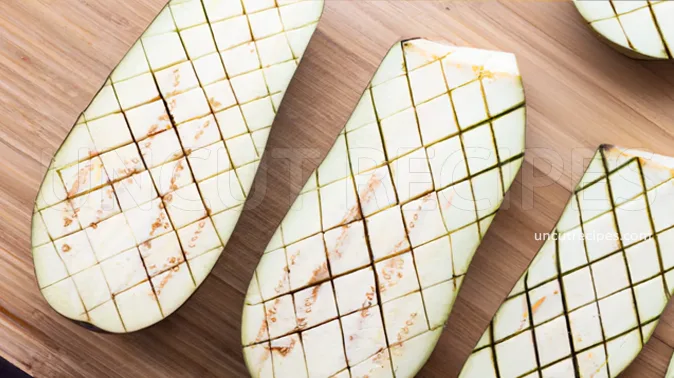
09 - To remove any bitter taste from the eggplants, soak them in water for about 10 minutes.
10 - After soaking, pat the eggplants dry using paper towels or a clean kitchen cloth. Then, place them on a baking sheet lined with parchment paper.
11 - Time for some flavor! Brush the open surface of each eggplant half with sesame oil.
12 - Now, flip the eggplants so the cut side (with oil) is facing down on the baking sheet.
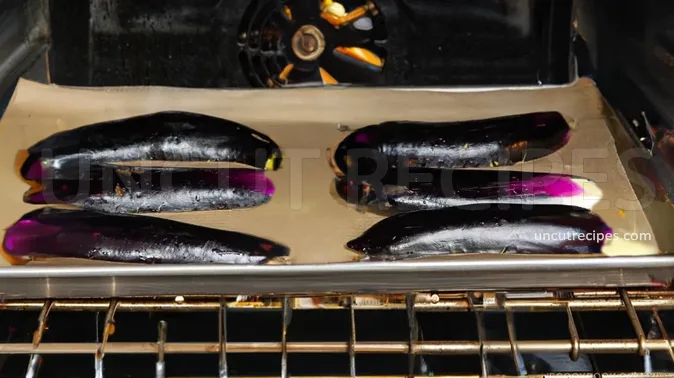
Baking Time:
13 - Place your prepared eggplants in the preheated oven and bake at 220°C (or 425°F) for approximately 15 minutes.
Preparing the Topping:
14 - While the eggplants are baking, let's prepare the topping. Thinly slice the green onions into rounds.
15 - Next, roll up the shiso leaves and cut them into thin strips. This cutting technique is often called 'julienne.'
Final Steps:
16 - After about 15 minutes, take a peek at the eggplants. Their skin should start to shrivel and the flesh should feel soft. If so, remove them from the oven. But don't switch off your oven yet! Change the oven setting to the broiler and keep the rack in the same position as before.
17 - Carefully flip over the eggplants, brush them with the sweet miso glaze you prepared earlier, making sure you coat the entire open surface.

18 - Now, place the glazed eggplants back in the oven, this time under the broiler. Let them broil for about 3-5 minutes, or until you see the glaze starting to bubble.
19 - Once done, remove the eggplants from the broiler. Remember, the tray will be hot, so use oven mitts for safety.
20 - Now for the final touch! Sprinkle your baked eggplants with the sesame seeds, sliced green onions, and the julienned shiso leaves. Serve your Miso Glazed Eggplants hot and enjoy!

Notes:
Choosing Eggplants: It's best to use Japanese eggplants for this recipe as they are more tender and have fewer seeds. If these are not available, you could use another variety, but please note that the texture and flavor may slightly vary.
Prepping the Eggplants: If your eggplants are particularly long, feel free to cut them in half crosswise before splitting them lengthwise. This can make them easier to handle and serve.
Miso Paste: There are various types of miso paste available in the market, such as red, white, or mixed miso. For this recipe, we use white miso, which has a milder and slightly sweeter flavor than red miso. Feel free to experiment with different types of miso to suit your taste preference, but keep in mind that this might alter the overall flavor of the dish.
Mirin Substitute: Mirin is a sweet Japanese cooking wine. If you don't have it on hand, a reasonable substitute could be a sweet white wine or a dry sherry mixed with a bit of sugar.
Sake Substitute: Sake is a type of Japanese rice wine. If you can't find it, you could use dry sherry or Chinese rice wine as a substitute.
Shiso Leaves: These leaves have a unique flavor that's hard to replace. However, if you can't find them, you can substitute them with a small amount of mint and basil combined.
Storing and Reheating: This dish is best served fresh. However, if you have leftovers, you can store them in an airtight container in the refrigerator for up to 3 days. To reheat, place them in an oven set at 180°C (or 350°F) for about 10 minutes or until thoroughly heated. Please note that the texture might change slightly when reheated.
Oven vs Broiler: In some ovens, the broiler is a separate compartment, while in others, it's a setting that heats the oven from the top. Please make sure you understand your oven's configuration before broiling the eggplants.
Monitoring the Broiling Process: Always keep an eye on the eggplants when they are under the broiler, as they can quickly go from perfectly browned to burned. Every oven is different, and the timing may need to be adjusted.
Importance of Scoring: The scoring step for the eggplants is critical as it allows the glaze and heat to penetrate better, resulting in a more flavorful and evenly cooked eggplant. Be careful not to cut too deep; you just want to score the surface.
Removing Bitterness: Soaking the eggplants in water helps to remove any bitterness. Don't skip this step, especially if you're using a different variety of eggplant.
Nutritional Information
( Per Portion )
|
Calories |
200 kcal (10%) |
| Total Carbohydrate | 25g (9%) |
| Cholesterol | 0mg (0%) |
|
Total Fat |
10g (13%) |
| Saturated Fat | 2g (10%) |
| Polyunsaturated Fat | 3g (12%) |
| Monounsaturated Fat | 4.5g (28%) |
| Trans Fat | 0g |
| Fibers | 6g (24%) |
| Protein | 4g (8%) |
| Sugar | 5g (10%) |
|
Vitamin A |
100 IU (2%) |
|
Vitamin B1 (Thiamin) |
0.2mg (13%) |
| Vitamin B2 (Riboflavin) | 0.1mg (8%) |
| Vitamin B3 (Niacin) | 2mg (10%) |
| Vitamin B5 (Pantothenic Acid) | 0.5mg (10%) |
| Vitamin B6 | 0.3mg (18%) |
| Vitamin B7 (Biotin) | 3mcg (10%) |
| Vitamin B9 (Folate) | 40mcg (10%) |
| Vitamin B12 | 0.1mcg (4%) |
| Vitamin C | 9mg (10%) |
| Vitamin D | 0 IU (0%) |
| Vitamin E | 1mg (7%) |
| Vitamin K | 50mcg (42%) |
| Choline | 25mg (5%) |
| Carnitine | 5mg |
|
Calcium |
40mg (4%) |
|
Chloride |
100mg (4%) |
| Chromium | 5mcg (14%) |
| Copper | 0.1mg (11%) |
| Fluoride | 4mcg |
| Iodine | 3mcg (2%) |
| Iron | 1mg (6%) |
| Magnesium | 30mg (7%) |
| Manganese | 0.4mg (20%) |
| Molybdenum | 5mcg (11%) |
| Phosphorus | 70mg (7%) |
| Potassium | 500mg (11%) |
| Selenium | 2mcg (4%) |
| Sodium | 450mg (19%) |
| Sulfur | 100mg |
| Zink | 0.7mg (6%) |
* Percent Daily Values are based on a 2,000 calorie diet. Your daily values may be higher or lower depending on your calorie needs.
** Nutrient information is available for all ingredients in this recipe. Amount is based on available nutrient data collected from all over the internet.
(-) Information is not currently available for this nutrient. If you are following a medically restrictive diet, please consult your doctor or registered dietitian before preparing this recipe for personal consumption. |
| Written by: Uncut Recipes | Disclaimer |


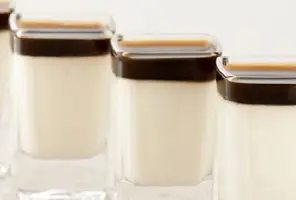

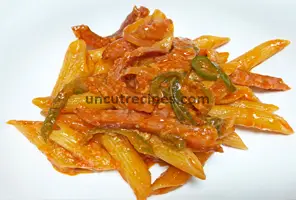
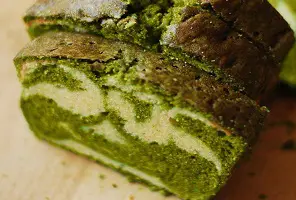








June 16, 2023
The Miso Glazed Eggplant recipe quickly became a favorite of mine!